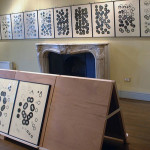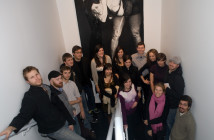Most works of art, especially in the visual arts, are created to capture concepts in a specific time, space or location. Object making, installation art, earth works or performance art are all about the here, now and for that matter the space, that sculpts the object, crafts the simulacra, and locates the conceptual.
The seven multi-panel drawings in David Lloyd Brown’s exhibition Genetics, on tour in the latter weeks of 2009 at theAyscoughfee Hall Museum, in Spalding, England embrace wider territory. Originally designed for the specific geographic location of Boston, Lincolnshire and shown in that city in 2007 at the Haven Gallery, this exhibition is the first of two series of works linking the two Bostons (Boston, Lincolnshire and the newer Boston, Massachusetts). The show is a metaphor celebrating the endless change and birth of the world around us.
Brown came to this project in 2005 when he encountered the Partnership for the Historic Bostons, a small band of American and English devotees committed to preserving the historic connection of Puritan America to its English origins in East Anglia where the show has been touring for the past two years. These groups (both the Partnership and the Puritans) proved ideal for the esthetic mining of a territory almost untouched by any other in artistic practice until now. A parallel species of drawings derived from the common ancestor of the first drawing in this series is planned for Boston, Massachusetts in the near future. This series will complete the cycle and bring closure to a body of work inspired by one city as the cultural ancestor of another.
This body of work does bring to mind some artists, notably the American conceptual artist Lowry Burgess, known for his multi-site installation in Afghanistan and on Easter Island designed to realign the earth’s axis between those two spots on the globe. Of influence as well might be the work of British minimalist, Norman Toynton whose paintings and installations in the 1970s and 80s explore sameness and difference in the sequential multi-paneled constructions of heavily painted pegboard.
From the catalogue essay written by New York critic and curator Joseph R. Wolin, we learn the single template used in each drawing bears a striking resemblance to a human phallus. Controversial in itself, the template/phallus has evoked criticism from some members of the scientific community who argue that genetics need not take place solely within a sexual context. Indeed it doesn’t, as Brown’s work insists. The vision driving this series of drawings is evolution and genetics. It is the vision of biological change, referenced in the titles of each drawing named after major contributors in the fields of genetics and evolution.
Additionally, Brown's work is an acknowledgement of the forces behind cultural and social evolution as symbolized by presenting these drawings in two cities one of which gave birth to the other 379 years ago that motivated Brown to create panel after panel of complex almost hieroglyphic abstractions. It is Brown’s location of his drawings to engage the cultural and topographical signified by these two cities that gestates new meaning to the problem of the decorative. Using templates and ordering systems, each drawing evolves from the physical structures in the drawing preceding it, taking the viewer on a complex journey through pattern, shape and decoration and locating the overall design in an evolutionary context.
- Interior and detail views of Genetics, by David Lloyd Brown.
"Genetics" was on view until December 18th at Ayscoughfee Hall Museum in Ayscoughfee Hall Museum, South Holland, Lincolnshire.
All images are courtesy of the artist, the author, and Ayscoughfee Hall Museum.







